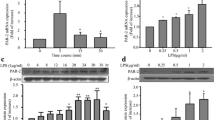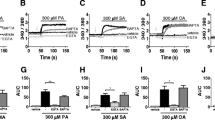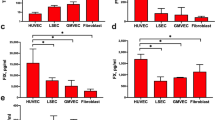Abstract
Increased procoagulant activity of vascular endothelial cells may be an important component in the pathogenesis of intravascular coagulation associated with gram-negative bacterial diseases. Two bovine endothelial cell (BEC) lines isolated from pulmonary arteries (ENS-2 and ENT-18) were used in this study to investigate procoagulant signal transduction pathways of endotoxin (lipopolysaccharide, LPS) —stimulated BECs. The endothelial cell line ENS-2 was sensitive to LPS as demonstrated by tissue factor (TF) expression, but in contrast, the ENT-18 endothelial cell line was unusually resistant to the effects of LPS. No remarkable quantitative difference in binding of radiolabeled LPS was detected between the two endothelial cell lines. A protein kinase C (PKC) activator (phorbol 12-myristate 13-acetate, PMA) failed to induce TF expression in either cell line at concentrations ranging from 0.05 to 1.00μM when used as a sole stimulus for the endothelial cells. However, when PMA was used in combination with LPS, PMA enhanced the stimulatory effect of LPS on the endothelial cells. In parallel experiments, PKC inhibitors (H-7 and GF 109203X) interfered with the stimulatory effect of LPS on the cells by decreasing tissue factor expression. We also found that an activator of adenylate cyclase, forskolin, similarly inhibited LPS-induced tissue factor activity. In contrast, protein tyrosine kinase inhibitors (genistein, lavendustin A) had no inhibitory effect on LPS-induced endothelial cell tissue factor expression. Our results collectively suggest that activation of PKC is an important step in stimulation of endothelial cells by LPS, and that LPS and phorbol esters may synergize to produce an enhanced stimulatory effect. Our results also suggest participation of cAMP in controlling LPS-mediated stimulation of endothelial cells, but fail to demonstrate a role for protein tyrosine kinase activity.
Similar content being viewed by others
References
Jandl, J. H. 1987. Blood. Textbook of Hematology. J. H. Jandl, editor. Little, Brown and Co., Boston. 965–1018.
Scarpati, E. M., andJ. E. Sadler. 1989. Regulation of endothelial cell coagulant properties: modulation of tissue factor plasminogen activator inhibitors and thrombomodulin by phorbol 12-myristate 13-acetate and tumor necrosis factor.J. Biol. Chem. 264:20705–20713.
Crossman, D. C., D. P. Carr, E. G. D. Tuddenham, J. D. Pearson, andJ. H. McVey. 1990. The regulation of tissue factor mRNA in human endothelial cells in response to endotoxin or phorbol ester.J. Biol. Chem. 265:9782–9787.
Noguchi, M., T. Sakai, andW. Kisiel. 1989. Correlation between antigenic and functional expression of tissue factor on the surface of cultured human endothelial cells following stimulation by lipopolysaccharide endotoxin.Thromb. Res. 55:87–97.
Bevilacqua, M. P., andM. A. Gimbrone, Jr. 1987. Inducible endothelial functions in inflammation and coagulation.Sem. Thromb. Hemostas 13:425–433.
Bevilacqua, M. P., J. S. Pober, G. R. Majeau, W. Fiers, R. S. Cotran, andM. A. Gimbrone, Jr. 1986. Recombinant tumor necrosis factor induces procoagulant activity in cultured human vascular endothelium: Characterization and comparison with the actions of interleukin 1.Proc. Natl. Acad. Sci. U.S.A. 83:4533–4537.
Schumann, R. R., S. R. Leong, G. W. Flaggs, P. W. Gray, S. D. Wright, J. C. Mathison, P. S. Tobias, andR. J. Ulevitch. 1990. Structure and function of lipolysaccharide binding protein.Science 249:1429–1431.
Tobias, P. S., K. Soldau, andR. J. Ulevitch. 1986. Isolation of a lipopolysaccharide-binding acute phase reactant from rabbit serum.J. Exp. Med. 164:777–793.
Wright, S. D., R. A. Ramons, P. S. Tobias, R. J. Ulevitch, andJ. C. Mathison. 1990. CD14, a receptor for complexes of lipopolysaccharide (LPS) and LPS binding protein.Science 249:1431–1433.
Schutt, C., T. Schilling, U. Grunwald, W. Schonfeld, andC. Kruger. 1992. Endotoxin-neutralizing capacity of soluble CD14.Res. Immunol 143:71–78.
Heumann, D., P. Gallay, C. Barras, P. Zaech, R. J. Ulevitch, P. S. Tobias, M. Glauser, andJ. D. Baumgartner. 1992. Control of lipopolysaccharide (LPS) -binding and LPS-induced tumor necrosis factor secretion in human peripheral blood monocytes.J. Immunol. 148:3505–3512.
Mathison, J. C., P. S. Tobias, E. Wolfson, andR. J. Ulevitch. 1992. Plasma lipopolysaccharide (LPS)-binding protein.J. Immunol. 149:200–206.
Breider, M. A., S. Kumar, andR. E. Corstvet. 1990. Bovine pulmonary endothelial cell damage mediated byPasteurella haemolytica pathogenic factors.Infect. Immun. 58:1671–1677.
Ryan, U. S. 1986. Immunofluorescence and immunocytochemistry of endothelial cell surface properties.J. Tissue. Culture Methods 10:27–30.
Pitas, R. E., T. L. Innerarity, J. N. Weinstein, andR. W. Mahley. 1981. Acetoacetylated lipoproteins used to distinguish fibroblasts from macrophages in vitro by fluorescence microscopy.Arteriosclerosis 1:177–185.
Stein, O., andY. Stein. 1980. Bovine aortic endothelial cells display macrophage-like properties toward acetylated [125I]-labelled low density lipoprotein.Biochim. Biophys. Acta 620:631–635.
Lay, J. C., D. O. Slauson, andW. L. Castleman. 1986. Volume-controlled bronchopulmonary lavage of normal and pneumonic calves.Vet. Pathol. 23:673–680.
Surprenant, Y. M., andS. H. Zuckerman. 1989. A novel microtiter plate assay for the quantitation of procoagulant activity on adherent monocytes, macrophages, and endothelial cells.Thromb. Res. 53:389.
Wollenweber, H. W., andD. C. Morrison. 1985. Synthesis and biochemical charaterization of a photoavtivatable, iodinatable, cleavable bacterial lipopolysaccharide derivative.J. Biol. Chem. 260:15068–15074.
Ulevitch, R. J. 1978. The preparation and characterization of a radiolabeled bacterial lipo-polysaccharide.Immunochemistry 15:157–164.
Ameria, A., M. N. Kuppuswamy, S. Basu, andS. P. Bajaj. 1992. Expression of tissue factor pathway inhibitor by cultured endothelial cells in response to inflammatory mediators.Blood 79:3219–3226.
Magnuson, D. K., R. V. Maier, andT. H. Pohlman. 1989. Protein kinase C: A potential pathway of endothelial cell activation by endotoxin, tumor necrosis factor, and interleukin-1.Surgery 106:216–222.
Car, B. D., D. O. Slauson, M. Dore, andM. M. Suyemoto. 1990. Endotoxin-mediated bovine alveolar macrophage procoagulant induction is dependent on protein kinase C activation.Inflammation 14:681–689.
Toulle, D., P. Pianetti, H. Coste, P. Bellevergue, T. Grand-Perret, M. Ajakane, V. Baudet, P. Boissin, E. Boursier, F. Loriolle, L. Duhamel, D. Charon, andJ. Kirilovsky. 1991. The bisindolylmaleimide GF 109203X is a potent and selective inhibitor of protein kinase C.J. Biol. Chem. 266(24):15771–15781.
Berridge, M. J. 1993. Inositol trisphosphate and calcium signaling.Nature 361:315–325.
Zioncheck, T. F., S. Roy, andG. A. Vehar. 1992. The cytoplasmic domain of tissue factor is phosphorylated by a protein kinase C-dependent mechanism.J. Biol. Chem. 267:3561–3564.
Faucette, K. J., C. J. Parker, T. McCluskey, N. J. Bernshaw, andG. M. Rodgers. 1992. Induction of tissue factor activity in endothelial cells and monocytes by a modified form of albumin present in normal human plasma.Blood 79:2888–2895.
Hepler, J. R. andA. G. Gilman. 1992. G Proteins.Trends Biochem. Sci. October:383–387.
Gallay, P., S. Carrel, M. P. Glauser, C. Barras, R. J. Ulevitch, P. S. Tobias, J. D. Baumgartner, andD. Heumann. 1993. Purification and characterization of murine lipo-polysaccharide-binding protein.Infect. Immun. 61:378–383.
Pazin, M. J., and L. T.Williams. 1992. Triggering signaling cascades by receptor tyrosine kinases.Trends Biochem. Sci. 374–377.
Lynn, W. A., andD. T. Golenbock. 1992. Lipopolysaccharide antagonists.Immunol. Today 13:271–276.
Pugin, J., C. C. Schurer-Maly, D. Leturcq, A. Moriarty, R. J. Ulevitch, andP. S. Tobias. 1993. Lipopolysaccharide activation of human endothelial and epithelial cells is mediated by lipopolysaccharide-binding protein and soluble CD14.Proc. Natl. Acad. Sci. U.S.A. 90:2744–2748.
Edgington, T. S., N. Mackman, K. Brand, andW. Ruf. 1991. The structural biology of expression and function of tissue factor.Thromb. Haemost. 66:67–79.
Khemlani, L. S., P. N. Bochsler, andJ. M. Maddux. 1993. Lipopolysaccharide-binding factors are present in bovine serum.BioFactors 4:33–36.
Bochsler, P. N., J. M. Maddux, N. R. Neilsen, andD. O. Slauson. 1993. Differential binding of bacterial lipopolysaccharide to bovine peripheral-blood leukocytes.Inflammation 17:47–56.
Author information
Authors and Affiliations
Rights and permissions
About this article
Cite this article
Yang, Z., Bochsler, P.N., Carroll, R.C. et al. Signal transduction pathways of bacterial lipopolysaccharide-stimulated bovine vascular endothelial cells. Inflammation 18, 221–233 (1994). https://doi.org/10.1007/BF01534563
Issue Date:
DOI: https://doi.org/10.1007/BF01534563




